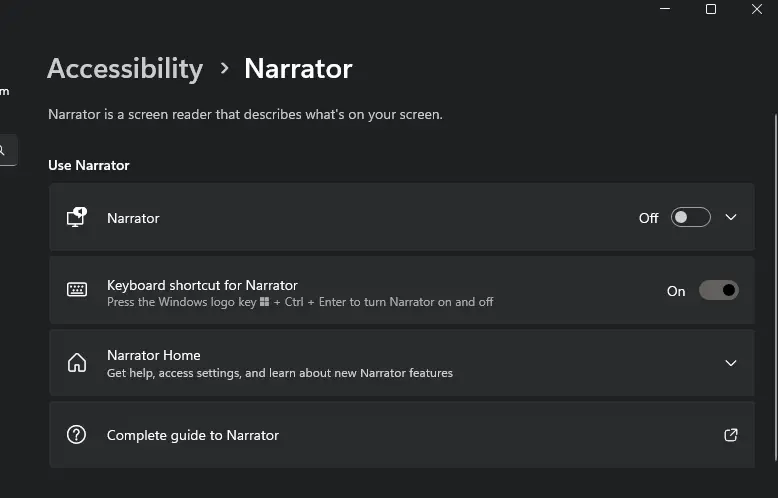How to disable Narrator.exe from narrating your life?
... if by "life", you mean "absolutely everything you do in Windows 11", that is. And Windows is life, right?

Doubling the price of environmentally friendly plastic bags is not helping this otter.
And Narrator in Windows is a life saver for people with vision impairment, if they can't afford a real screen reader (I know - that sounds heretical, like saying that "replacing plastic bags with cotton totes is killing the otters").
But not everyone likes a robotic voice in their head reading stuff - and slowing down their computer while doing it.
Background
Table of Contents
Table of Contents
I think this must be a low point in my career. I'm writing a blog post intro roasting an accessibility feature in Windows.
But I think it's worthwhile to document solutions to problems. And Narrator freezing my dev box certainly is a problem. Especially so, since Windows forces this feature on to everyone, no matter whether they need or want it or not - that's not very "Personal Computing", is it?
Problem
Why would this even be a problem to anyone? It's not like you have to use Narrator in Windows, right?
Well, even if you don't have to, it will start bothering you by itself - if you misremember keyboard shortcuts or fat-finger them. See, narrator.exe is started by hitting Ctrl+Win+Enter, which (at least with the combination of keyboard, fingers and unrealistic expectations of an acceptable typing speed) is relatively easy to hit.
Besides, you know what they say about monkeys, typewriters and Shakespeare, right? When you spend 8-10 hours on a computer every week day, eventually you'll hit the sacred combo of Narratorness, whether you wanted it or not.
It's no biggie, right? You can just shut it down?
Well - in theory, sure. But narrator.exe might cause such lag in your $4000 pro-gamer ultraproductive pwnage-machine, that it'll stop listening to keyboard commands.
The window might also pop open BELOW your other windows.
It could also be unresponsive.
It might refuse to close.
And all the while, it'll read aloud whatever you're trying to do to shut it down.
Infuriating!
Solution
Okay, so since the year of Yammering is long gone, let's cut to the chase: How do you get rid of Narrator, preferably for good?
We'll get to that - but first we'll treat the immediate issue at hand.
1. Close the Narrator by hitting Ctrl+Win+Enter
In theory, you can close the app down by hitting the same keyboard shortcut combo again.
In practice, this doesn't always work. Narrator might refuse to close.
I swear, it almost feels like Windows thinks it knows what you want better than you...
2. Kill the narrator.exe
"Kill" or rather "Taskkill" - run the following command in an elevated terminal window (because narrator.exe is so strong you can not kill it without administrator permissions):
taskkill /F /IM narrator.exe
With that admin-level spell, you should be good.
To be fair, why should you be able to shut down an app that you accidentally started? That would be preposterous! Much better to require you to contact an admin to get rid of that pesky little voice inside your head.
Or headphones. Which ever of the two.

YES - I tried without admin permissions first. Geez, stop bothering me.
The point is, the voice should now be silenced. For a short while.
But the problem is, if you regularly smash your keyboard with all of your fingers in rage, it's very likely you inadvertedly hit Ctrl, the Windows key, and Enter. Those are very easy to hit all at once, you know.
So perhaps you'll want to disable Narrator permanently?
3. Disable the Narrator hotkey
You can, for a short while, disable the keyboard shortcut for Narrator from the settings:
Settings > Accessibility > Narrator
It'll look somewhat like below:

How to disable Narrator for a while
The problem with this setting is that it will re-enable itself inconsistently consistently (read that a few times, will you?) with some Windows updates.
"Which ones?", you might ask. Nobody knows, but it does happen. And it happens all the time, some of the time.
So we'll need to go nuclear.
4. Trick Narrator.exe never to start again
There's a very convenient little switch in the actual Windows Settings UI ("regedit.exe", that is) that helps you avoid this issue in the future. Why it's hidden, beats me - but the bit below is copied from "Microsoft answers" (link in "References"):
Press the Windows key + R and in the search bar type regedit
then head to this directory: HKEY_LOCAL_MACHINE\SOFTWARE\Microsoft\Windows NT\CurrentVersion\Image File Execution Options
Click on the Edit button and hover over the New option to select Key.
When the new key is created, rename it as narrator.exe.
With narrator.exe being selected, right-click on the empty space on the right side.
Hover over New and select String Value. Name it Debugger and double-click on it
When the Edit String window appears, type 1 in the Value data field and click OK.
Restart your computer to confirm your Narrator feature is disabled permanently.
... very convenient and user-friendly, right?
Or you can just run the following in PowerShell:
reg add "HKEY_LOCAL_MACHINE\SOFTWARE\Microsoft\Windows NT\CurrentVersion\Image File Execution Options\narrator.exe" /v Debugger /t REG_SZ /d "%1" /f
5. Remove your System32 folder to free up some space and Narrator will also go away
Okay, I'm kidding. I just got inspired by the clunkiness of the last option.
I mean - who would think that if you want to disable a disruptive, optional feature on your PERSONAL COMPUTER, you'd have to apply registry hacks to achieve it?
So in short, don't remove System32. You might need it. Unless you give up with Windows.
That said, you could always remove narrator.exe from under System32! To do that, you have to perform some dark permissions-related magic first, though.
My recommendation is actually NOT to do any of this. The user-friendly UI hack (regedit.exe) is powerful enough that it should disable Narrator for good. Or at least for a longer while!
But in case you still want to do it, here's how:
Open PowerShell as an admin
Run: takeown /f C:\Windows\System32\Narrator.exe
Run: cacls C:\Windows\System32\Narrator.exe /grant administrators:F
Run: rename-item -path "C:\Windows\System32\Narrator.exe" -NewName "Narrator_old.exe" -force
Weep, for it's sad anything like this would ever need to be done 😢
Restart your "PC"
.. and with that, you should have successfully applied the nuclear option!
Narrator.exe will be gone until Microsoft forces another formatting/reinstalling of your machine - and if my experiences are anything to draw on, you should be good for at least a couple of months!
Comments
No comments yet.